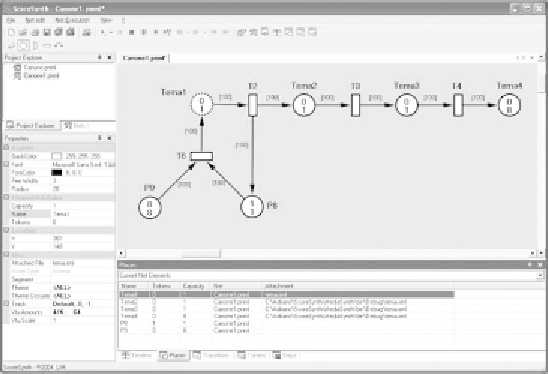Information Technology Reference
In-Depth Information
Figure 10. The ScoreSynth application
application generates the XML line by reading
the current event in the “Spine Elements” list
box, and by computing the coordinates of the
rectangle. After adding a new line, the current
element indicator is moved forward and the map-
ping process continues. When this procedure
comes to an end, each logic event in the LOS part
of the original MX file has at least one element
associated in Notational layer, indicating where
it is represented in the score image.
On the other side, MX Audio Mapper is the
application used to map the logic events in audio/
video clips (see Figure 9). This software is similar
to the previous one, but—instead of mapping
the graphic representations of scores—it maps
audio/video performances. The mapping process
is achieved by “tapping” the rhythm on a button.
To map a clip, some parameters must be defined
in advance: the timing unit per quarter used in
Logic layer and the rhythm figure to be processed
(crotchet, quaver, etc.). The user opens the MX
file (already containing a Logic layer) and the
audio/video clip and starts hitting the “TAP!”
button (with the mouse or the space bar): the result
is the hand-made synchronization of the selected
rhythmic figures. When this process is completed,
the MX spine is processed and all the timings of
the events are computed (in seconds), interpolat-
ing events between two consecutive taps. Finally,
the computed points of synchronization can be
fine-tuned by hearing the selected position in the
clip and adjusting the wrong timings.
As stated in Section 4, the MX format has a
layer devoted to structural information. The soft-
ware tool, which we have developed to compile
this layer, is ScoreSynth (see Figure 10). This
application works with Petri Nets (Petri, 1976),
a formalism used at LIM since 1980 as the basic
tool for music description and processing. In Music
Petri Nets we manage music objects (MOs), that
is anything that could have a musical meaning
and that we consider an entity, either simple or
complex, either abstract or detailed. Such entities,
identified by unique names, can present some re-
lationship with other music objects. We can treat
music objects at various abstraction levels within
a hierarchical context of description, applying to
them transformation algorithms in order to cre-
ate new modified objects (Haus, 1997). Through
ScoreSynth, a user can describe the structure of a

Search WWH ::

Custom Search